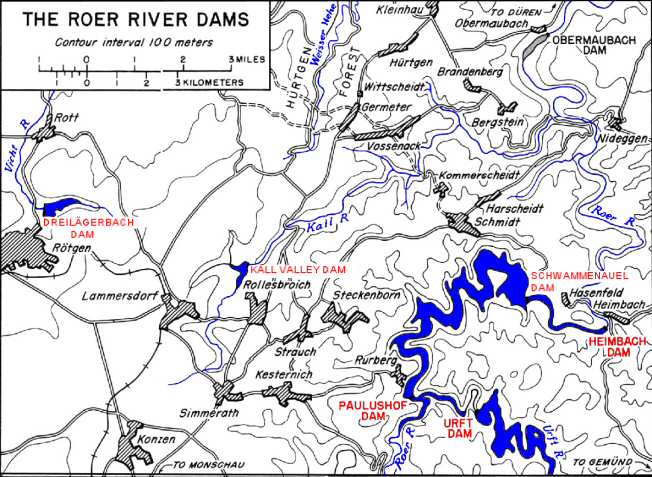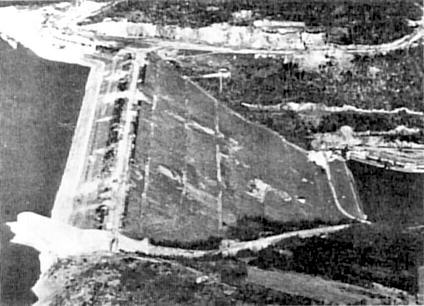Second Battle for the Dams
by Rainer Monnartz
Jan. 30, 1945 (Tuesday)
In the northern part of the Ardennes the retreat of the German units and the general offensive of the Americans on the Roer dams coincide seamlessly.
After weeks-long skirmishes for individual pillboxes and town sectors the attack breaks out along the entire length of the front between Simmerath and Wahlerscheid. Due to deployment on the Ardennes (Bulge) front only weakened units of the 52nd and 272nd VGD, sections of 3rd Panzergrenadierdivision and of the 3rd Fallschirmägerdivision stand on the German side, while the Americans launch their assault with four refreshed infantry divisions (78th, 9th, 99th and 2nd), as well as an armored division. Already before noon Rohren falls to units of the 9th Infantry Division, advancing out of the Monschau-Höfen sector. During the day, Alzen, Huppenbroich, Eicherscheid, Konzen and Imgenbroich follow. The 78th Infantry Division moves forward in the direction of the Schwammenauel Dam from the Simmerath-Rollesbroich sector.
The road intersection at Wahlerscheid is re-taken by the Americans.

Jan. 31, 1945 (Wednesday)
The Americans continue their attack in the Monschau Corridor.
North of Reichsstraße 258 (today: road B258 Monschau-Schleiden), they march in meter-high snow through the forest and occupy the Forsthaus "Rothe Kreuz". Attacking from Imgenbroich, Menzerath is taken and units advancing out of Rohren occupy Widdau, so that Monschau is finally taken completely out of the front-line and for the first time the Westwall pillboxes south of Aachen to Wahlerscheid are completely in the hands of the Americans. For more than four months the residents of the "Pearl of the Eifel", Monschau, have had to live in fear and trembling.
The Germans react with the repossession of the frontline Dedenborn - Finkenauel - Leykaul - Wahlerscheid.
Feb. 01, 1945 (Thursday)
The German line of defense in the Monschau sector crumbles again. The US Infantry Divisions, moving forward from Rocherath and Krinkelt almost unhindered, finally occupy the intersection of Reichstraße 258 at the Forsthaus Wahlerscheid, The Americans have called it “Heartbreak Crossroads.”
Capture of Wahlerscheid and Hammer by the Americans.
Feb. 02, 1945 (Friday)
In the upper Roer Valley the German defense collapses. A makeshift line of defense is erected in front of Erkensruhr, and as a result it is not possible to hold Hirschrott, Finenauel and the area around the Forsthaus Dedenborn itself.
The American units, attacking from Rollesbroich, are able to occupy the sector around Kallbrück, which has been held successfully by the Germans for months.
South of Wahlerscheidt the Americans successfully break through in the direction of Schleiden. Schöneseiffen and Harperscheidt – situated on Reichstraße (road) 258 – are taken by the 2nd Infantry Division. The 9th Infantry Division advances from the direction of Gemünd. From the Monschau Forest the attack is concentrated directly on Dreiborn.
Further south the Germans are forced to withdraw from Udenbreth.
Feb. 03.1944 (Saturday)
Dreiborn, strategically important because of its height above the dams, continues to be stubbornly defended in bitter house-to-house fighting for a few more hours before the last German soldiers pull out.
The Americans are also successful in the area of the former military training area, Vogelsang, where the lead tanks reach Herhahn and capture the German artillery which has been firing accurately for months.
The Americans reach Einruhr through the valley of Erkensruhr. Further north the struggle around Kesternich ends. Before the Americans can maintain the upper hand, there are once again heavy losses in house-to-house fighting in this linear village which has already changed hands many times in December.
Feb. 04, 1945 (Sunday)
Units of the 9th Infantry Division advance over Wollseifen and Vogelsang Castle in the direction of the Urft reservoir and, only a short while later, are standing on the Urft dam wall. The Schwammenauel reservoir is also reached by American units on this day. Attacking from Kesternich, they succeed almost without effort in taking Ruhrberg.
Feb. 05, 1945 (Monday)
Schmidt, the bitter end for the Americans in the “All Souls’ Day Battle for Vossenack and Schmidt” is still a nightmare. During the night at 03.00 an attack which will last for several days is launched on the town in which the Germans have been allowed to feel virtually unchallenged since November. For the time-being the Americans advance on Strauch from the Kall Valley. In the southern sector of operations Hellenthal falls.
Feb. 06, 1945 (Tuesday)
The American attack on Schmidt only progress with difficulty. Troops advancing past Strauch in an easterly direction are able to take Hechelscheidt, which lies above Woffelsbach, but there are no other reports of success.
In the south, the Americans inexplicably fail to continue the attack on Schleiden and Gemünd, despite weak German resistance.
Feb. 07, 1945 (Wednesday)
The direct attack on Schmidt leads through Strauch and Steckenhorn. Both towns have been cut off days before with the capture of Hechelscheidt.. The German defenders, however, continue to defend themselves in the truest sense, down to the last shell. When the Americans have finally taken both villages practically no stone is left standing on another.
While several kilometers of roadway from the “Buhlert” woods to Schmidt remain to be conquered. US units are able to advance on Kommerscheidt out of the Kall Valley, and reach the first houses of Schmidt in the evening. The bitter fighting for the town continues for another two days.
Feb. 08, 1945 (Thursday)
In the battle for the Schwammenauel Dam, the Americans advance on Hasenfeld from several sides, but it can at first be defended successfully by the Germans. Schmidt falls to the Americans.
Note: The attempt of the Americans to capture Schmidt from Vossenack, through the Kall Valley, floundered as a result of high losses. (see "All Souls' Day Battle", 11.02. - 11.08.1944)
The attack over the mountain ridge, Simmerath-Schmidt, was the successful route. Of particular notice here is that the Americans already occupied Lammersdorf on 09.14.1944, and so stood only a small distance from the mountain ridge Simmerath-Schmidt.

The Schwammenauel Dam on the Roer River
Feb. 09, 1945 (Friday)
The Schwammenauel Dam and the town of Hasenfeld fall to the Americans. One more time the Germans are able to register a win against the overwhelming foe. While the American sappers search the dam for explosives at night, German explosives commandoes who have been left behind, destroy a dewatering conduit and the discharge valves at the outlet of the 2.7 km. power tunnel (Kermeterstollen) out of the Urft reservoir to the Heimbach Power Plant.

Heimbach Hydroelectric Power Plant
The Urft and Schwammenauel reservoir carry a lot of water at this time due to the snow melt and the continuing rainfall.
As a result, a steady flow of water gradually inundates the Roer Valley, where the Allies originally planned the beginning of their “Operation Grenade” (the crossing of the Roer River between Düren and Heinsberg) for 10 February.
The start of the offensive will be on 23.02, 1945, 14 days after the originally planned date.
The blowing up of the discharge valves at the Heimbach power plant marks the tragic end of the Battle of the Huertgen Forest. Despite high American losses, the objective – preventing the flooding of the Roer Valley by taking the Roer River Dams and the area around the Upper Roer River – is not achieved.
Feb. 10, 1945 (Saturday)
The battle for the Roer River Dams is ended. The last German defenders in Schmidt are taken prisoner or forced to flee through the woods. If there were not the problems with crossing the Roer (as a result of the German destructions near the Urft and Schwammenauel reservoirs, and with the added flooding because of the thaw, the Roer has become a raging torrent), the way to Cologne would be practically free. The Americans content themselves with spending the coming two weeks gathering all available units to the west of the river.
Feb. 23, 1945 (Friday)
The American 12th Army Group begins the attack east over the Roer – “Operation Grenade”, Battle for the Rhineland.
Feb. 24, 1945 (Saturday)
At night, a German combat team breaks through American lines and blows up an old road bridge, which had become visible in the reduced water level of the Schwammenauel reservoir.
03.02, 1945 (Friday)
The Americans capture the town of Heimbach which is the last German stronghold near the Schwammenauel Dam.
03.04, 1945 (Sunday)
Schleiden and Gemünd are lost to the Americans.

German to English translation made by Scorpio and Christine Greenthaner.
